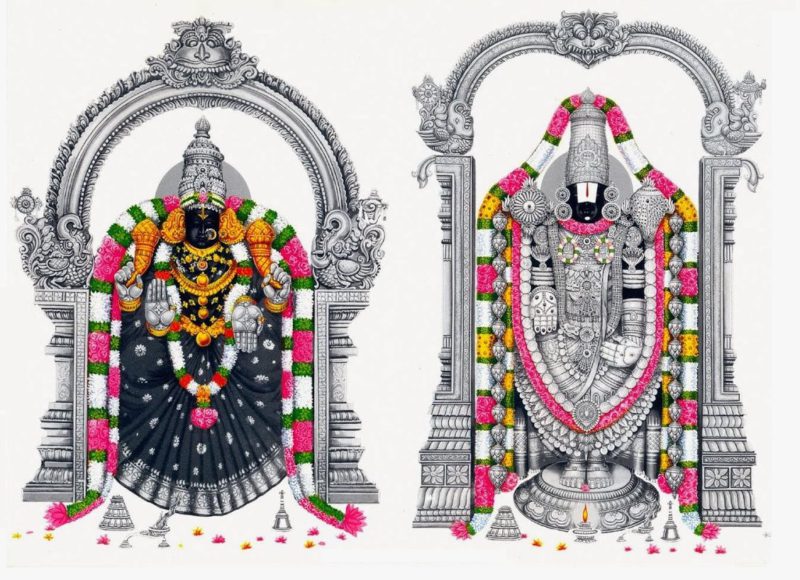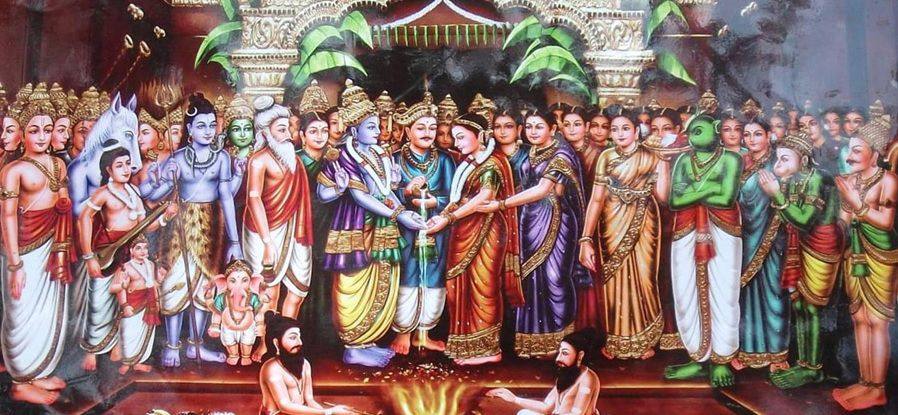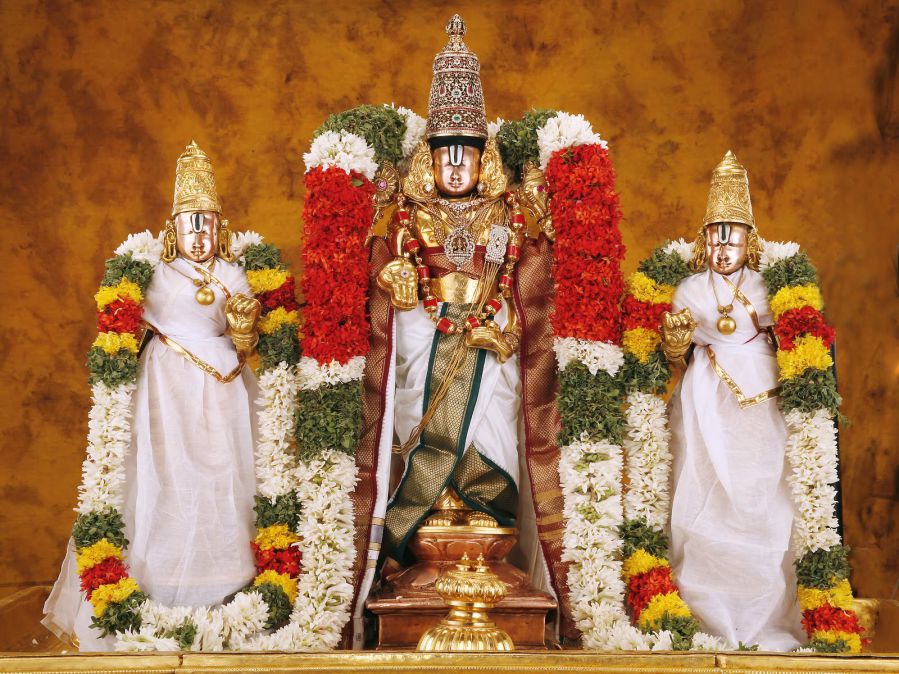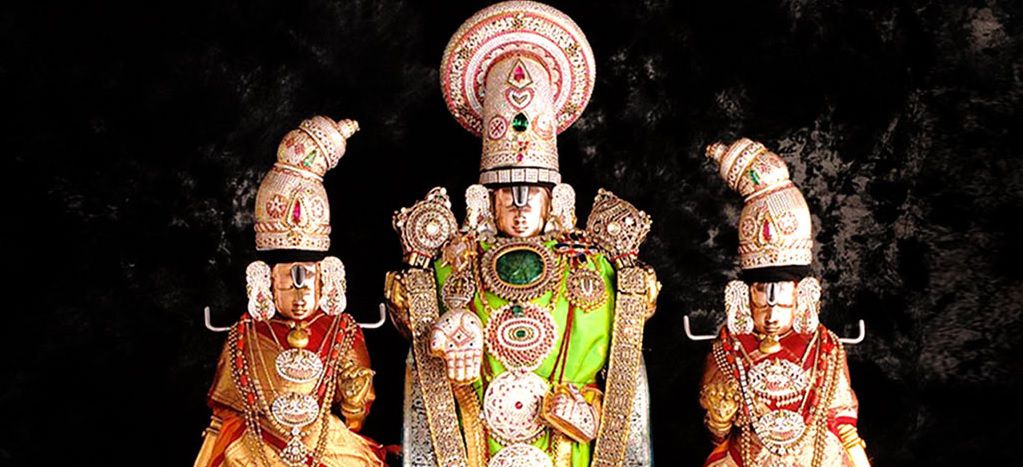No products in the cart.
According to the Hindu scriptures, Vishnu, out of love towards his devotees, incarnated as Venkateswara and appeared for the salvation and upliftment of humanity in this Kali Yuga age. It is considered the supreme form of Vishnu in this age. The Venkateswara swami temple is also called Kaliyuga Vaikuntam. Venkateswara is an avatar of Lord Vishnu who is one of the most popular deity among devotees of Vishnu in South India. He is also known as Venkatachalapathi or Venkataramana or Tirumal devar or Varadaraja or Srinivasa or Balaji or Bithala. He has a dark complexion and four hands. In his two upper hands he holds a discus (a symbol of power) and a conch’s hell (a symbol of existence). With his lower hands extended downward he asks devotees to have faith and surrender to him for protection. The supreme temple of Venkateswara is at Tirupati and every Lord Vishnu devotee wants to visit this temple at least once in life. Once some rishis headed by Kashyapa began to perform a sacrifice on the banks of the Ganges. Sage Narada visited them and asked them why they were performing the sacrifice and who would be pleased by it. Not being able to answer the question, the rishis approached Sage Bhrigu.
To reach a solution after a direct ascertainment of reality, Sage Bhrigu first went to Satyaloka, the abode of Lord Brahma. At Satyaloka, he found Lord Brahma, reciting the four Vedas in praise of Lord Narayana, with each of his four heads, and attended upon by Saraswati. Lord Brahma did not take notice of Bhrigu offering obeisance. Concluding that Lord Brahma was unfit for worship, Bhrigu left Satyaloka for Kailasa, the abode of Lord Shiva. At Kailasa, Bhrigu found Lord Shiva spending his time pleasantly with Parvati and not noticing his presence. Parvati drew the attention of Siva to the presence of the sage. Lord Shiva was furious at Bhrigu’s intrusion and tried to destroy him. The sage cursed Lord Shiva and left for Vaikuntam. At Vaikuntam, Lord Vishnu was reposing on Adisesha with Sri Mahalakshmi in service at His feet. Finding that Lord Vishnu also did not notice him, the sage was infuriated and kicked the Lord on His chest, the place where Mahalakshmi resides. At once, Lord Vishnu hastened to apologize to the angry sage and pressed his feet to allay the pain caused to Bhrigu’s leg. In doing so the Lord removed the eye in the foot of the sage, stripping of his special powers. Thereupon, the sage concluded that Lord Vishnu was the most supreme of the Trimurtis and told the rishis the same.
Mahavishnu’s Avatar as Lord Venkateswara
Sri Mahalakshmi was angered by the action of her Lord in apologizing to Bhrigu who committed an offence. Out of anger and anguish she left Vaikuntha and resided in Karavirapur now known as Kolhapur. The Kohlapur Mahalaxmi temple is considered on the four Shakti Peethas in Maharashtra. After the departure of Mahalakshmi, a forlorn Lord Vishnu left Vaikuntam and took abode in an ant-hill under a tamarind tree, beside a Pushkarini on the Venkata Hill, meditating for the return of Lakshmi, without food or sleep. This was the place where Lord took the form of Varaha to rescue Mother Earth form the deep ocean. Taking pity on Lord Vishnu, Brahma and Maheshwara decided to assume the forms of a cow and its calf to serve Him. Surya, the Sun God informed Mahalakshmi of this and requested her to assume the form of a cowherds and sell the cow and calf to the king of the Chola country. The king of the Chola country bought the cow and its calf and sent them to graze on the Venkata Hill along with his herd of cattle. Discovering Lord Vishnu on the ant-hill, the cow provided its milk, and thus fed the Lord. Meanwhile, at the palace, the cow was not yielding any milk, for which the Chola Queen chastised the cowherd severely. To find out the cause of lack of milk, the cowherd followed the cow, hid himself behind a bush and discovered the cow emptying her udder over the ant-hill. Incensed over the conduct of the cow, the cowherd aimed a blow with his axe on the head of the cow. However, Lord Vishnu rose from the ant-hill to receive the blow and save the cow. When the cowherd saw the Lord bleed at the blow of his axe, he fell down and died of shock.
The cow returned, bellowing in fright and with blood stains all over her body, to the Chola King. To find out the cause of the cow’s terror, the King followed her to the scene of the incident. The King found the cowherd lying dead on the ground near the ant-hill. While he stood wondering how it had happened, Lord Vishnu rose from the ant-hill and cursed the King saying that he would become an Asura because of the fault of his servant. The King pleaded innocence, and the Lord blessed him by saying that he will be reborn as Akasa Raja and that the curse would end when the Lord will be adorned with a crown presented by Akasa Raja at the time of His marriage with Padmavati. With these words Lord turned into stone form. Thereafter, Lord Vishnu in the name of Srinivasa, decided to stay in Varaha Kshetra, and requested Sri Varahaswami to grant Him a site for His stay. His request being readily granted, Srinivasa ordained that a pilgrimage to His shrine would not be complete unless it is preceded by a bath in the Pushkarini and darshan of Sri Varahaswami, and that puja and Naivedyam should be offered to Sri Varaha swami first. Vishnu built a hermitage and lived there, attended to by Vakuladevi who looked after him like a mother.
Goddess Padmavathi’s Marriage to Lord Venkateswara

In olden times, Lakshmi, in the form of Vedavati, was staying in an ashram in the forests. At that time, Ravana, the lord of Lanka tried to tempt her. In anger, Vedavati cursed him saying that she would bring about his death. To show how true her words were, Vedavati walked into the fire, but Agni, the Fire God rescued her. He took Vedavati to his house and entrusted her to his wife’s care. When Ravana was about to carry away Sita from Panchavati, in the absence of Rama and Lakshmana, Agni appeared and offered Vedavati to Ravana as the real Sita who was kept with him by Rama to evade Ravana. Ravana was tricked into thinking that Vedavati was the real Sita.
Ravana took Vedavati to Lanka thinking she was the real Sita, while Agni took Sita to his house and asked his wife Swahadevi to look after her. After the destruction of Ravana, Vedavati entered the fire when rejected by Rama. Then, Agni, offered the real Sita to Rama. Rama then questioned her as to who the other lady by her side was, Sita informed Rama that the lady was Vedavati who endured Ravana’s torture for ten months in Lanka for her sake. Sita requested Rama to accept Vedavati also as his spouse. But Rama declined her request saying that he believed in having only one wife during his life time. However, He promised to wed her in her next birth as Padmavati, born as the daughter of Akasa Raja, when Rama himself would take the form of Srinivasa.
One day, Lord Srinivasa, who was hunting, chased a wild elephant in the forests surrounding the hills. In the elephant’s pursuit, the Lord was led into a garden, where Princess Padmavati and her maids were picking flowers. The sight of the elephant frightened the Princess and her maids. But the elephant immediately turned around, saluted the Lord and disappeared into the forest. Lord Srinivasa, who was following on horseback, and saw the frightened maidens. However, He was repulsed with stones thrown at Him by the maids. He returned to the hills in haste, leaving His horse behind. Vakuladevi found him lying on his bed, not interested in anything. The Lord informed her that unless he married Princess Padmavati. The Lord then narrated the story of her (Padmavati’s) previous birth and his promise to wed her. After listening to Srinivasa’s story of how he had promised to marry Vedavati in her next birth as Padmavati, Vakuladevi realised that Srinivasa would not be happy unless he married Padmavati. She offered to go to Akasa Raja and his Queen and arrange for the marriage. On the way she met the maid-servants of Padmavati returning from a Shiva Temple. She learnt from them that Padmavati was also pining for Srinivasa. Vakuladevi went along with the maid servants to the Queen

Meanwhile, Akasa Raja and his queen Dharanidevi were anxious about the health of their daughter, Padmavati. They learnt about Padmavathi’s love for Srinivasa of Venkata Hill. Akasa Raja consulted Brihaspati about the marriage and was informed that the marriage was in the best interest of both the parties. Kubera lent money to Lord Srinivasa to meet the expenses of the marriage. Lord Srinivasa, along with his consorts and Lord Brahma and Lord Siva started the journey to the residence of Akasa Raja with his vahana, Garuda. At the palace entrance, Lord Srinivasa was received by Akasa Raja with full honors’ and taken in procession on a mounted elephant to the palace for the marriage. In the presence of all the Devas, Lord Srinivasa wed Princess Padmavati, thus blessing Akasa Raja.
Bibi Nancharamma – Wife of Lord Venkateswara (Balaji)
Bibi Nancharamma, a Muslim woman, is believed to be a wife of Lord Venkateswara, by many Muslims of Rayalaseema (a region comprising of 4 districts in the present state of Andhra Pradesh).
After Goddess Lakshmi cursed Lord Venkateswara and Goddess Padmavati to turn into a stone she repents for her mistake. She realizes that she has insulted the Lord and decides to incarnate in a human form and with her devotion and prayer win back a place in his heart.
It is believed that she was reborn as Nancharamma, to a Muslim king several centuries later. With her staunch love and worship to the Lord, she attained Moksha and the God adorned her a place back in his heart.

The legend has it that Lord Balaji married a Muslim woman Bibi Nancharamma, who was the daughter of a Muslim general, in 1311 AD, after he was immensely pleased by her devotion. Her idol has a pride of place in Tirumala temple precincts,” the priest said.
It is not unusual in Tirumala to allow backward castes and Dalit’s to certain rituals. In fact, every morning rituals such as opening the door, offering food to God (modati darsanam, naivedyam) are performed by them. In addition, even classical poets like Anaamayah or any other Vaishnava respect Bibi Nancharamma, a Muslim woman as the consort of the deity.
Some people believe that though she was not his actual wife, she was a great devotee to the lord and reached him through her worship. (Similar to Meerabai and Sri Krishna).






